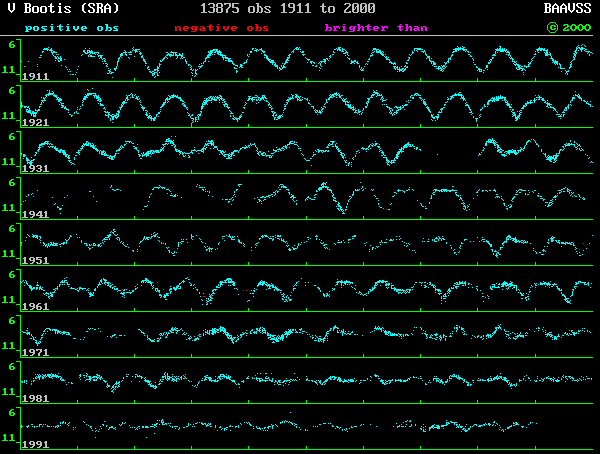
from VSSC95
At first glance, V Bootis might seem to be ‘just another boring semiregular variable’. Indeed, the GCVS details for it (type = SRa, range = 7.0-12.0v, period = 258d, spectrum = M6e) suggest that it is a fairly typical example of the large-amplitude red semiregular variables, of which many hundreds are known. Even the note at the back of the GCVS to the effect that both the period and amplitude vary (the latter ‘strongly’) is not untypical for this type of star (indeed, it is why they are called ‘semiregular’ in the first place).
However, over the past decade there have been several detailed studies of the long-term light-curve of V Boo and these have revealed that something rather unusual might be going on. These studies are summarised by Szatmary, Gal and Kiss in Stobie & Whitelock (eds), ‘Astrophysical Applications of Stellar Pulsation’, ASP Conference Series, Vol 83, 417-418, 1995, a paper which unfortunately includes no references.
Visual observations by the AAVSO, BAA and other organisations going back to 1900 have been used and searches have been made for multiple periods, period changes, amplitude changes, and for chaotic behaviour. Whilst no good evidence has been found for systematic changes in the 258 day period, nor for chaos, clear evidence has been found for a secondary period, and, more importantly, for a systematic decrease in the amplitude of the 258 day period.
The secondary period is about 137 day, and has a full (ie: max to min) amplitude of about 0.5 mag. Both period and amplitude have remained more or less unchanged throughout the past 80 years. However, the amplitude of the 258 day period averaged 2.8 mags in 1913-1930, 2.0 mags in 1930-1970, and after 1970 decreased from 2.0 mag to only about 0.5 mag in 1994. This means that now the 258 day and 137 day periods have about the same amplitude and interact to produce a rather complicated light-curve with an extreme range of only about 1.0 mag. This is very different from the almost Mira-type behaviour exhibited by the star in the first few decades of this century.
So, on the face of it, V Boo has ‘evolved’ from a Mira-like SRa star into an SRb star in less than a hundred years. If this is due to actual long-term evolutionary changes in the star then this is of considerable importance for testing the theories of stellar evolution and pulsation.
Further visual observations are very important in order to extend the light-curve into the next century and to check whether the amplitude of the 258 day period goes to zero as the current trend suggests.
